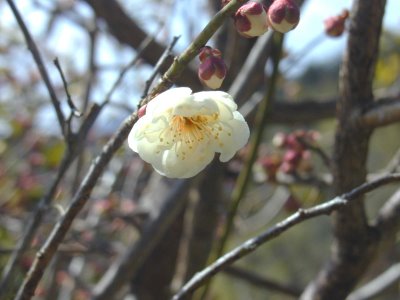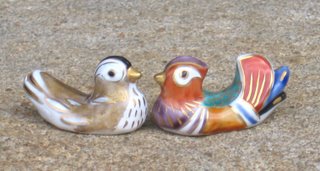 梅一輪 一輪だけじゃ 春寒し ume ichi rin ichi rin dake ja haru samushi  one plum blossom just one blossom - spring is still cold |
This morning we had a radio interview starting at seven in our garden, looking for spring in our area, but it was still very cold ! And I had to cite one haiku on the spot.
I was reminded of this famous haiku:
Ume ichi-rin ichirin hodo no atatakasa
Hattori Ransetsu (1654-1707)
one plum blossom
brings us just one more
step to the warmth
(Tr: Gabi Greve)
. Radio Interview March 2006 .
:::::::::::::::::::::::::::::::::::::::::::::::::::::::::::::::::::::::::::::::::::::::::::::::::::::
Tensaku by Susumu Takiguchi
This haiku poses a number of interesting questions, one of which is what is called 'honka-dori'. Strictly speaking, this is a technical term for waka and renga, and later was also adoped for haikai-no-renga with specific rules about its use. It therefore is not really a term to be used for haiku but nevertheless people do. Honka in honka-dori, also called moto-uta, means an original poem (if it is an original text or episode, it is called hon-setsu).
Honka-dori is an action to write a new poem but alluding to a honka. Such allusions, it seems, are banned or shied away in the American-led haiku trend but it is an integral and most legitimate part of Japanese tradition. Basho used this technique all the time, so much so that one gets under the impression that every other haiku by him is an allusion.
As Gabi has explained, this haiku is alluded to a haiku by Ransetsu, which is so famous that it is in the 'flesh and bone' of all Japanese and ranks as high as a group of masterpieces which include Basho's old pond haiku. Ume (plum, Prunus mume) represents that part of the time of the year which sits between winter and spring, or more precisely in the overlapping period of the two seasons. It therefore presupposes the possibility of the remaining cold from the winter, even if the kigo itself is for spring (of course it also depends on different varieties of ume, some bloom early, others late).
Ransetsu's haiku is like either saying that the cup is half full or half empty, i.e. saying the same thing from different viewpoints. Namely, it is talking about the warmth which increases day by day but by so doing it is also implying that coldness still lingers. Here, the kigasanari (double kigo) is seen between ume and atatakasa (warmth), both of which are kigo for spring but it is applied with care and therefore the result is very effective.
Honka-dori can become a mere parody which is of less literary merit. Gabi's haiku is not a parody but verging dangerously on it. What can make it not so?
In Gabi's haiku, there is also kigasanari, ume and haru samushi (also, haru-samu, samuki-haru, shun-kan, ryou-sho). Since the remaining coldness is given, as explained above, there should be more to be done with the kigo haru samushi.
Also, as previously pointed out, there is a slight mixing of kogo and bungo, and I would just like to keep recommending Gebi to go on studying bungo.
(This is a project dealing not with haiku in English but in Japanese. But it may be useful to point out that the word 'blossom' seems to be more commonly used as a collective noun, or even talking about individual flowers it seems more common that it is used in plural form, i.e. blossoms. So, it is normally either 'blossom' as a collective noun or 'blossoms'. Therefore, it would be safe to use the word 'flower' instead. However, I must ask native-speakers of English for right answers)
Thus my TENSAKU for this haiku is:
ume ichirin
ichirin dake ja
mada samui
(all in kogo)
or
ume ichirin
ichirin naredo
yo-kan ari
(all in bungo)
ume ichirin
ichirin ni shite
sae-kaeru
........
Kengin, Susumu
Thank you so much, Susumu sensei.
I like the koogo 口語 better, but I will work on my bungo !
A few days later we even had snow on the plums !
plums in snow !
shades of white
on my canvas
:::::::::::::::::::::::::::::::::::::::::::::::::::::::::::::::::::::::::::::::::::::::::::::::::::::
. WKD : Plum blossoms (ume)
[ . BACK to WORLDKIGO . TOP . ]
:::::::::::::::::::::::::::::::::::::::::::::::::::::::::::::::::::::::::::::::::::::::::::::::::::::








7 comments:
very nice haiku, gabi san! very nice!
robert wilson
http://groups.yahoo.com/group/simply_haiku/message/14043
Thanks Robert san!
GABI
::::::::::::::::::::::::::::::::::::::::::::::::::::::::::::::::::::::
Dear Gabi san
Thank you very much
It is funny this year.
Cheeery blossoms, apricot blossoms, and the other will bloom
together like Tohoku area( north Japan)
I saw full of cherryblossoms in Itou last weekends
Izu peninsula area was warmer
etsuko
http://groups.yahoo.com/group/cherrypoetryclub/message/26984
We still have rather cold, Etsuko san! And the flowers are cold !
Gabi
::::::::::::::::::::::::::::::::::::::::::::::::::::::::::::::::::::::
gabi san
a brave little blossom....:)
nice haiku
J.D.
::::::::::::::::::::::::::::::::::::::::::::::::::::::::::::::::::::::
here, we're still a few weeks away from the first blossom. this is very well done.
Very nice, Gabi.
Here too - in fact Ireland's March has been colder than January or February!
turbid olive oil
reluctant to come out
spring salad
Best wishes
Norman
::::::::::::::::::::::::::::::::
Thanks for your spring salad, Norman!
And a THANK YOU ! to Eric for popping in !
Gabi
::::::::::::::::::::::::::::::::::::::::::::::::::::::::::::::::::::::
i love it gabi san
aloha from the rain...' ' ' rain' ' ' rain
5 weeks of rain mind you im not complaining my high desert is growing grass ....a lawn
shanna, hawaii
...................................
Take care, Shanna san !
GABI
::::::::::::::::::::::::::::::::::::::::::::::::::::::::::::::::::::::
Lovely, gabi.
early spring
who will carry the word
to the wind
Post a Comment